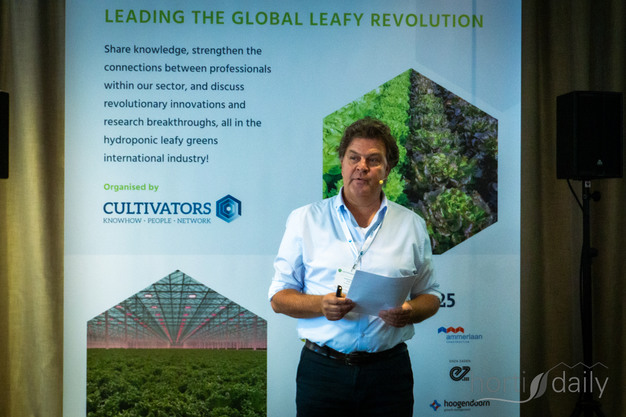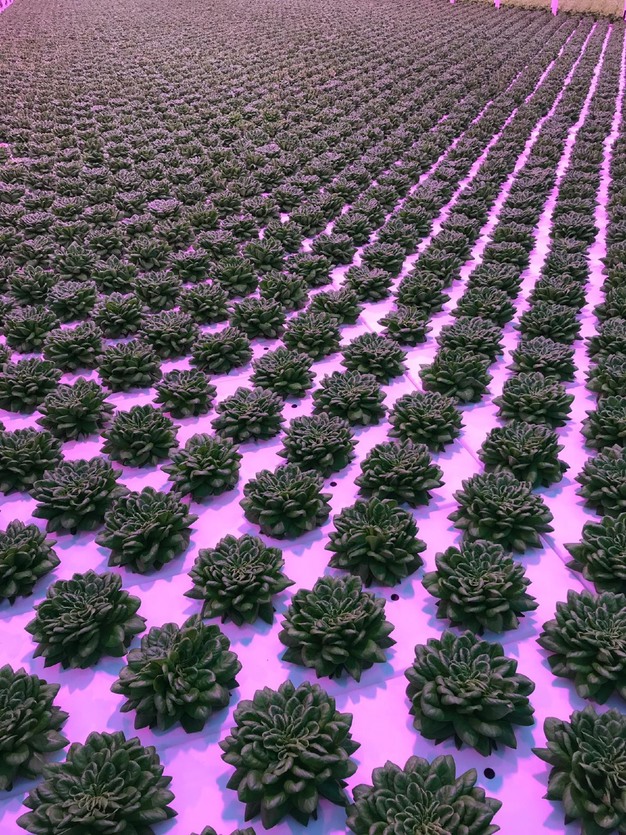In the early days of LED lighting in leafy greens, it wasn't uncommon to be labeled a cowboy. That's how Arnold de Kievit, International Sales Manager at Oreon, described the first phase of the technology's implementation. Speaking at the Leafy Hydroponics Event, Arnold traced the past 15 years of development in LED horticultural lighting for leafy greens, dividing the period into four distinct phases. The transition, he explained, has been shaped by evolving grower demands and technical progress in lighting configuration, intensity, efficiency, and spectral flexibility.
 © Arlette Sijmonsma | HortiDaily.com
© Arlette Sijmonsma | HortiDaily.com
As Arnold mentioned, the implementation of leafy greens was initiated and accelerated by grower demand. "They wanted to have better, consistent growth quality, year-round production, more yield. And well, if you bring more light, then you'll get more yield," he says, adding this is, of course, true only up to a certain light intensity. "Since LEDs obviously, and especially our water-cooled LEDs, generate less heat, light intensities can easily go up."
Pilots and cowboys (2009–2014)
Looking back, with projects realized in the Netherlands, Belgium, Germany, Austria, Denmark, Switzerland, Hungary, Asia (Japan), and North America, it seems switching to LEDs was a natural transition — but that's not how it went. Arnold recalls people actually seeing them as cowboys. "They did not recognize the color of the light, as they were used to yellowish light. All of a sudden, there were pink lines lights. We had to explain a lot, talk a lot. And finally, in this first period, a lot of pilots were set up."
 © Oreon
© Oreon
During this phase, LED lighting was introduced cautiously, typically in hybrid setups alongside existing HPS installations. Configurations were often limited by high prices, unfamiliarity with the technology, and questions about crop response. Most projects used hybrid lighting systems, either supplementing HPS or introducing LEDs where previously no artificial lighting was installed.
Light intensity in this period was low — typically between 50 and 90 μmol/m²/s — resulting in DLIs around 10 to 13 mol/m²/day. Spectrum design was minimal: mostly red (93%) with a small percentage of blue (7%) for optimal photosynthesis and biomass build-up, relying heavily on natural sunlight to balance the spectrum. Dimming and spectral adaptability were not present. Efficiency hovered just above HPS levels, with output around 1317 1375 μmol/s from 600 W fixtures. The cost per μmol was approximately €0.60, and yields were in the range of 35–40 kg/m²/year, especially in baby leaf production.
 © Oreon
© Oreon
Step-by-step acceptance (2015–2019)
As the technology matured, grower confidence increased. "This was the phase of step-by-step acceptance," Arnold said. "We started to see more customized configurations, and pricing and efficiency both improved."
HPS usage declined, with LEDs gradually taking over — 80/20 or even 100% LED setups emerged. The intensity increased to 200 μmol/m²/s in baby leaf crops, with staged lighting schemes across the crop cycle (e.g., 100–150–200 μmol/m²/s over three phases). DLI targets rose accordingly.
Dimming was introduced in this period, although it was often limited to basic switching. Spectral composition expanded to include small additions of far-red, and the first examples of spectral zoning within a single production system were tested, such as in Belgian lettuce operations.
Fixture efficiency reached up to 3.1 μmol/J, and new 1000 W fixtures delivered up to 3000 μmol/s. The price per μmol dropped, and yields doubled compared to the initial phase.
 © Oreon
© Oreon
The new standard (2020–2025)
"LED has become the new standard. Most growers we work with have moved to full LED installations," Arnold stated.
Standard intensities now reach 300 μmol/m²/s for baby leaf and 150 μmol/m²/s for head lettuce. DLI targets range from 23 to 28 mol/m²/day, depending on crop type. With dimmability becoming common, fixed high-intensity lighting combined with output control is preferred over multi-stage intensity approaches.
Spectral configurations have widened. "We've always been spectrum-independent," Arnold said. "Customers provide a recipe, and we build as close to that as possible within technical boundaries." Far-red has become standard in many setups, typically around 10%, and tunable spectra are emerging, although not yet the norm.
Fixture output now ranges from 5000 to 7400 μmol/s, with efficiencies up to 3.8 μmol/J. Prices per μmol have declined further, and yields surpass 100 kg/m²/year in baby leaf production. Oreon has introduced non-water-cooled fixtures in this phase, while still offering water-cooled systems — a core part of their design history.
 © Oreon Up next: the latest water cooled Monarch LED
© Oreon Up next: the latest water cooled Monarch LED

What's next (2026 and beyond)
Looking ahead, Arnold sees full LED becoming a baseline. Light intensities and DLIs are expected to rise, dimmability will be standard, and tunable spectra will become more economically viable. Less and less fixtures will be needed since the output will rise to levels of 7500 to 10000 µmol/s, making that the price per installed µmol will continue to go down.
"More growers are now asking for vertical propagation under LED, with transfer to greenhouses for finishing," Arnold noted. "Strong young plants from multilayer setups can help achieve even higher yields."
While Oreon doesn't position itself as a research institute, Arnold closed with a teaser: "We're starting something new — dynamic control of the PSS value without far-red penalty. We can't disclose much yet, but the first results look promising."
For more information:
Oreon
Lorentzlaan 6
3401 MX IJsselstein, Netherlands
+31 30 760 0660
info@oreon-led.com
www.oreon-led.com
